When it comes to pursuing an active and engaging lifestyle, few sports match the thrill of tennis. Playing on your very own tennis court can be a dream come true, offering convenience, privacy, and unlimited opportunities for practice. While the idea of building a tennis court might seem daunting, this comprehensive guide is tailored for beginners to help you understand the process, costs, and essential considerations involved in bringing your own tennis court to life.
Understanding The Basics Of Tennis Court Construction
Before delving into the construction process, it’s crucial to grasp the fundamental components of a tennis court. A standard tennis court is rectangular in shape, measuring 78 feet in length and 27 feet in width for singles matches. The court is divided into two equal sides by a net, and it’s essential to ensure that the dimensions are accurate to adhere to official standards.
Selecting The Ideal Location
Choosing the right location for your tennis court is the first step towards making your dream a reality. Ideally, the court should be situated on a level surface to avoid drainage issues and excessive leveling costs. Consider factors such as sunlight exposure, wind patterns, and proximity to other structures to create an enjoyable playing environment.
Determining The Budget
Understanding the potential costs involved is a critical aspect of the planning process. The cost of building a tennis court can vary significantly based on factors such as court type, materials used, and local construction rates. On average, the cost can range from $25,000 to $80,000 or more. It’s advisable to consult with professional court builders to obtain accurate cost estimates tailored to your specific needs.
Choosing The Right Court Surface
Tennis courts can be constructed with various playing surfaces, each offering distinct characteristics. The three primary types of court surfaces are hard courts, clay courts, and grass courts. Hard courts are popular due to their durability and low maintenance requirements, while clay courts offer slower gameplay and reduced impact on joints. Grass courts provide a faster playing surface but demand more upkeep.
The Construction Process
Site Preparation: Clear the chosen area of any vegetation and debris. The ground should be level and well-drained.
Excavation and Grading: Excavate the area to the required depth, accounting for the base materials and surfacing. Proper grading ensures optimal drainage.
Base Construction: Create a stable foundation using a combination of crushed stone, gravel, and a binder material like limestone. This base provides stability and helps with water drainage.
Surface Installation: Depending on your chosen surface, install the appropriate materials. For hard courts, this involves laying an acrylic or asphalt surface. Clay courts require a clay mixture, and grass courts need turf installation.
Markings and Accessories: Mark the court lines accurately according to official dimensions. Install net posts, net, and any additional accessories like fencing, lighting, and seating.
Legal And Regulatory Considerations
Before embarking on your tennis court construction journey, be sure to research and comply with local zoning regulations, permits, and any homeowner association rules. Ensuring your project meets legal requirements will prevent any future complications.
Maintenance And Upkeep
Maintaining your tennis court is essential to ensure its longevity and optimal playing conditions. Regular cleaning, resurfacing when needed, and addressing any surface issues promptly will keep the court in top shape for years to come.
Conclusion
Building a tennis court might seem like a complex endeavor, but with the right guidance and preparation, it can be an achievable goal. By understanding the basics, assessing your budget, selecting the right location, and following a systematic construction process, you can create a tennis court that becomes a centerpiece of your active lifestyle. Whether you’re aiming for friendly matches or serious training, your very own tennis court can offer endless enjoyment while enhancing your property’s value and appeal.




